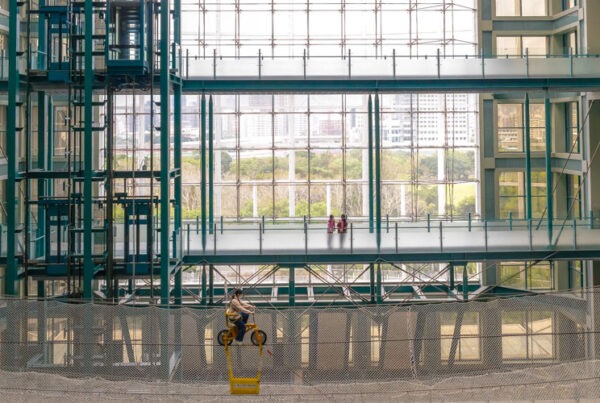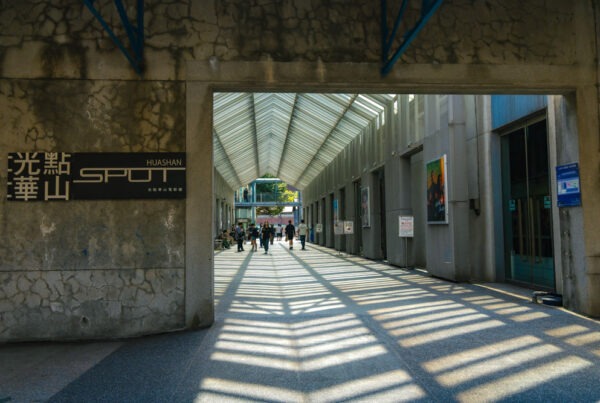Award-Winning Designer Johnny Chiu Inspires with Refreshing Ideas
TEXT | JENNA LYNN CODY
PHOTOS | JC. ARCHITECTURE AND DESIGN
Vintage iron grilles weaving intricate patterns across windows. Plants sprouting on sills and outer walls. Dense urban cores, convenience stores, five-story walk-ups, industrial sprawl, jungle-clad hills. These are some of the elements of the Taiwanese aesthetic that are interpreted by local designers in their work, both in Taiwan and on the world stage. Johnny Chiu, founder of JC. Architecture and Design, is one such talent. He recently sat down with Travel in Taiwan to discuss not just today’s Taiwanese design, but also its history, identity, and future.
Chiu was born in Taiwan and spent his early years here, but his design journey began overseas. He lived and worked in New Zealand, Australia, the U.S., Sweden, and Japan, studying architecture and design first at Columbia University in New York and later at the Royal Melbourne Institute of Technology (RMIT).

Although an illness brought him back to Taiwan, there were other factors that influenced his choice to remain in his country of birth. Seeking a challenge to stave off depression during the final phase of his PhD, he took on the design of the Happier Café in 2015. This temporary café and art installation was housed in the former National Air Force Command Headquarters in Taipei, since 2018 used by the Taiwan Contemporary Culture Lab (C-Lab; clab.org.tw).

“Instead of looking for on-the-shelf products like the West would normally do, I began to search into the production history (and) manufacturing capacity of Taiwan,” he said, referencing Taiwan’s long history with Original Equipment Manufacturing (OEM). “If you go into the factories, if you go to the source – even before they roll out these things, before they are pressed, painted, baked, or whatnot – that original thing (is what) we have a real abundance of.”
He used these concepts of raw materiality, affordability, and abundance when designing Happier Café, which encompassed 1,300 rolls of paper spread across walls, ceilings, and floors. For six months, visitors could draw and write anywhere within the space to express their joy. The paper was then rolled up into a “time capsule of happiness” for future exhibitions.
JC. Architecture and Design was founded by Chiu in 2010. Since then, the company has worked on all manner of projects, including the National Taipei University Library, with a series of bridges incorporated between buildings where students can interact. This was followed by the shop at the Taipei Fine Arts Museum (TFAM; www.tfam.museum), drawing on the metabolism movement from 1960s~1970s Japan to build a modular storefront that is just as much an art piece as a place of commerce.

Other elements in Taiwan’s design language that inspire Chiu include temporality, efficiency, and speed. These ideas are used to cultivate more abstract design principles that inform his projects. He attributes common architectural features in Taiwan such as the five-story apartment walk-ups, iron window grilles, and use of cheaper or less durable materials to a sense of “temporariness” which was endemic to Martial Law-era construction.
Residents “put those (window) cages up, then just stuff them with boxes,” Chiu observed. “Suddenly you have this house without any light. It’s kind of sad. But society is changing. If you go to the south, you can see a lot of window-grille masterpieces. Some designers are taking that as design inspiration.”
Anyone who has spent time in Taiwan is familiar with local expectations of, say, a convenience store on every corner. Chiu says this extends to local business culture as a whole. “The client wants something very fast from us,” he noted. “At the same time, that gives us many opportunities. A colleague of mine from Britain will have two projects a year, we have 30…but we can experiment a lot more, speed it up, (engage in some) trial and error…(be) more economical.”
“The client wants something very fast from us. At the same time, that gives us many opportunities”
One project inspired by these ideas of speed and economy was the Bloom Chair, which won a Golden Pin design award in 2022. Chiu’s team used leather from Kobe beef cattle, the thinness of which is not ideal for traditional furniture. They found that this also renders the leather stretchier and more fibrous. The chair’s lightweight honeycomb design was inspired by the red-paper pineapple lanterns common across Taiwan.

Transport design has become another cornerstone of Chiu’s portfolio, including a ferry plying the route between the city of Kaohsiung and the Penghu Islands, a Taipei Metro car, and a Taiwan Railway tourist train, all of which have brought both challenges and successes. The main challenge with the ferry design was making a six-hour boat ride competitive with a 40-minute flight. “So if the boat doesn’t compete on speed, maybe we can slow down and enjoy (the journey),” Chiu said. “What kind of enjoyment? The slow life of Penghu…the tidal slowness, walking by the sea, paddling, snorkeling. This turns into materiality and color.”

For the metro car, Chiu looked at the industrial sectors along the metro system’s Circular Line to create an artistic showcase, complete with “credits” at different stations for those involved. “These (areas) have the best of Taiwan,” he said. “These masters make the bolts and furniture, they are the best carpenters, world champions in their own right. We wanted to bring their craftsmanship to this line to showcase their talents. So (it was) a collaborative community process. A disadvantaged women’s association helped us weave (the textiles). ‘Mosquito nets’ diffuse the light, rattan masters worked on the poles.”
Internationally, Chiu’s most famous design is likely Taiwan Railway’s “Future Express” tourist train, a repurposed seven-carriage “Moving Kitchen” that rides between Taipei and the city of Taitung. The design is minimalist, with curving lines and a neutral black, white, and beige Art Deco-inspired palette that evokes both the past and the future. Oversized windows direct attention to one of Taiwan’s greatest assets: its natural beauty.

“Taiwan is already very beautiful. We didn’t have to ‘design’ everything, just lift up cabins and ceilings to allow the beauty to come in”
“Taiwan is already very beautiful,” Chiu noted. “So we didn’t have to ‘design’ everything, just lift up cabins and ceilings to allow the beauty to come in.”
As with the Future Express, Chiu’s favorite projects relate to tourism. These include the design library Not Just Library and restaurant concept Island No. 133, both located in Taipei’s Songshan Cultural and Creative Park (www.songshanculturalpark.org). The former is housed in what was once a bathhouse; the latter in an old machine repair plant.


“The news (about Taiwan) is always about missiles, ships – there’s a missed opportunity here. It’s important for us designers to unpack these historical and cultural places, to showcase to the world our rich cultural history, future, and identity,” he said. “That would be a beautiful thing.”
JC. Architecture & Design
(柏成設計)
Website: www.johnnyisborn.com
About the author
Jenna Lynn Cody
Jenna is an American woman living and working in Taipei, Taiwan.












